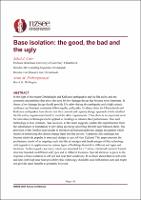| dc.contributor.author | Carr, Athol | |
| dc.contributor.author | Puthanpurayil, Arun | |
| dc.date.accessioned | 2021-06-22T04:01:59Z | |
| dc.date.available | 2021-06-22T04:01:59Z | |
| dc.date.issued | 2021-04-14 | |
| dc.identifier.uri | https://repo.nzsee.org.nz/xmlui/handle/nzsee/2396 | |
| dc.description.abstract | In the light of the recent Christchurch and Kaikoura earthquakes and the life safety and economic uncertainties they pose, the need for “low damage design” has become more important. In theory a “low damage design” should provide life safety during the earthquake and a high seismic resilience and business continuity following the earthquake. Evidence from the Christchurch and Kaikoura earthquakes have shown that the conventional “capacity design” approach which satisfied the life safety requirements failed to meet the other requirements. Thus, there is an important need for innovative technologies to be applied to buildings to enhance their performance. Base isolation, as the name suggests, isolates the superstructure from the substructure or foundation by providing an energy absorbing flexible layer in-between.At present, this technique has become relatively popular in structural design in parts of New Zealand. This paper carefully investigates the advantages and disadvantages of this technology with regards to its applications in various types of buildings founded in different soil types and locations. In addition, the implication of a future increase in the spectral demand is also investigated. To this regard case study results are presented for 3, 7 and 10 storey reinforced concrete framed structures founded on different soil types. Special attention is given to the response of base isolation in soft soil and near fault conditions.On soft soils and sites with high near fault possibility this technology might not give the same benefits as presently believed. A possible cost-effective retrofitting strategy is also suggested for such existing buildings. | |
| dc.language.iso | en | |
| dc.publisher | New Zealand Society for Earthquake Engineering | |
| dc.relation.ispartofseries | 2021;0083 | |
| dc.subject | Engineering assessments for general purposes and potentially earthquake-prone buildings | |
| dc.subject | Improving resilience of lifelines and infrastructure | |
| dc.title | Base isolation: the good, the bad and the ugly | |
| dc.type | Article | |

